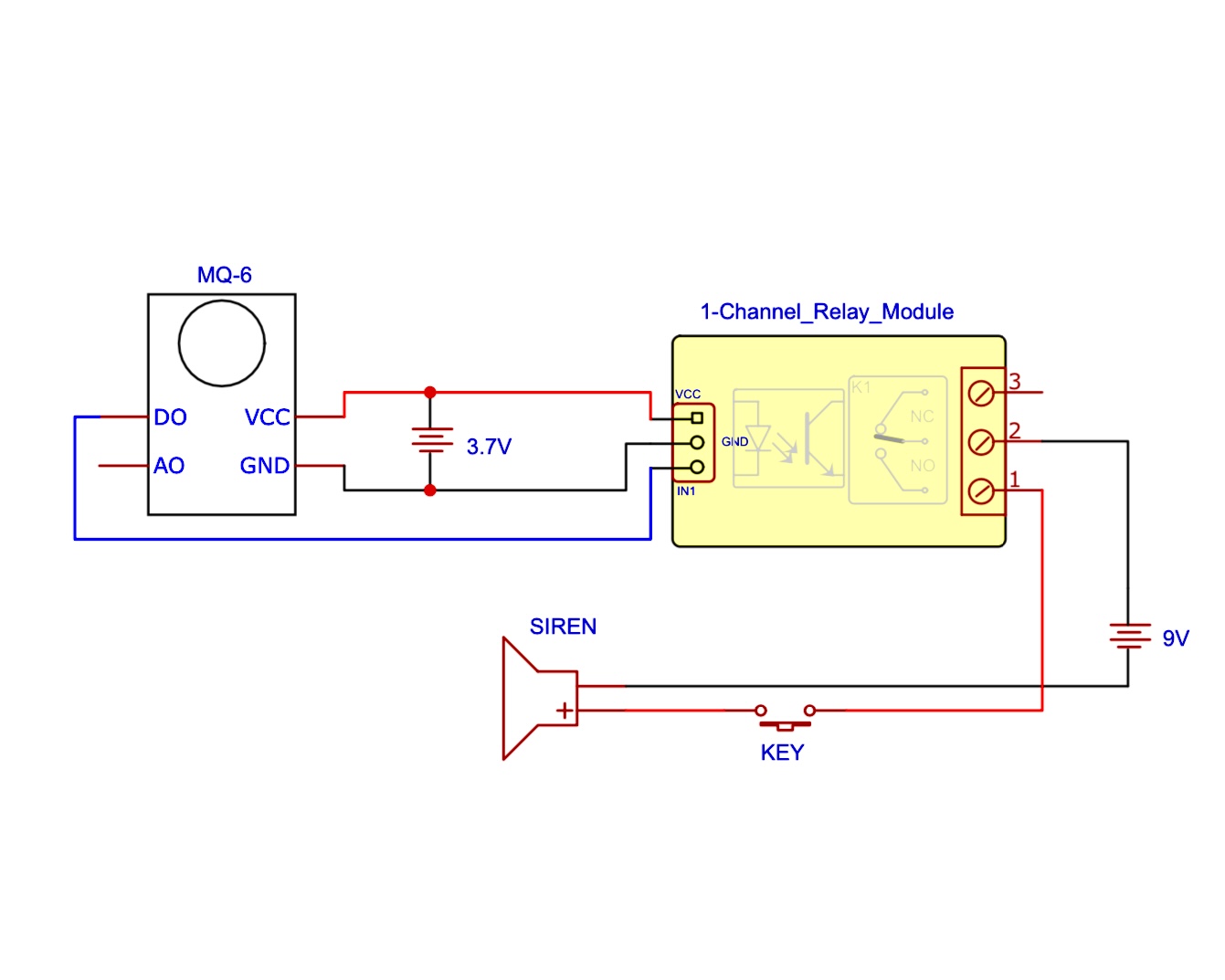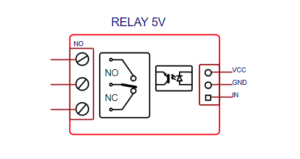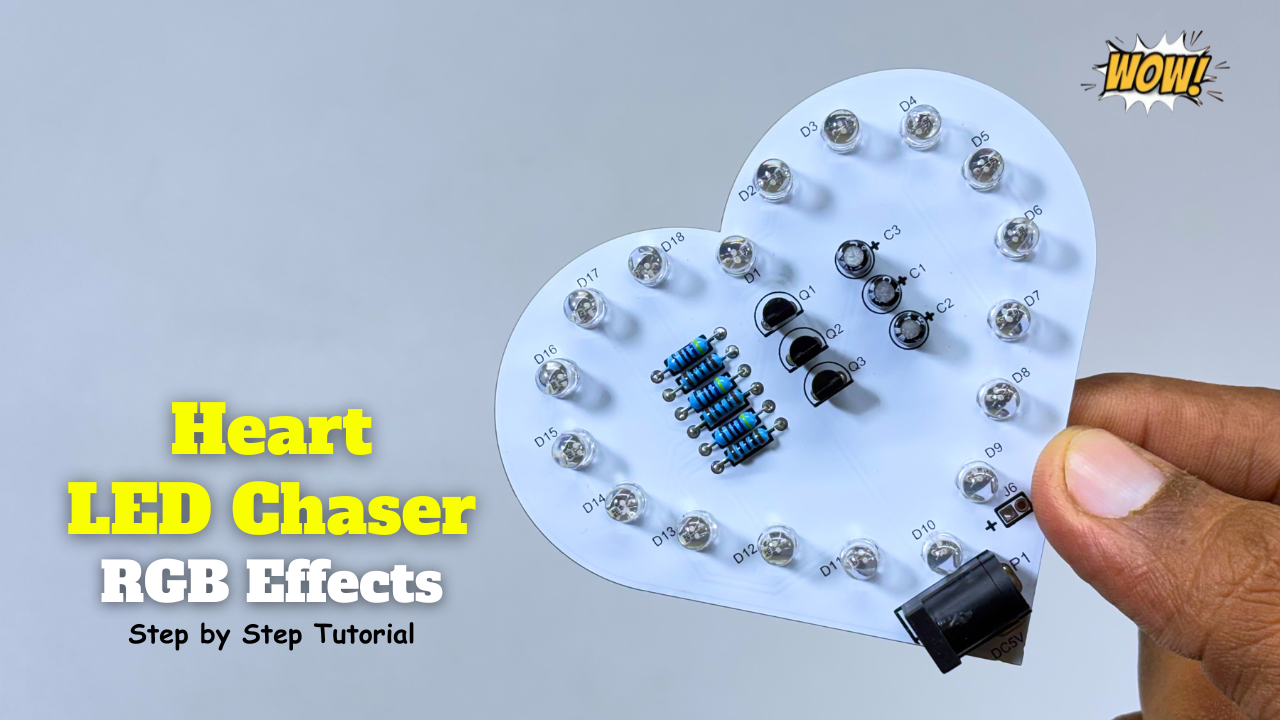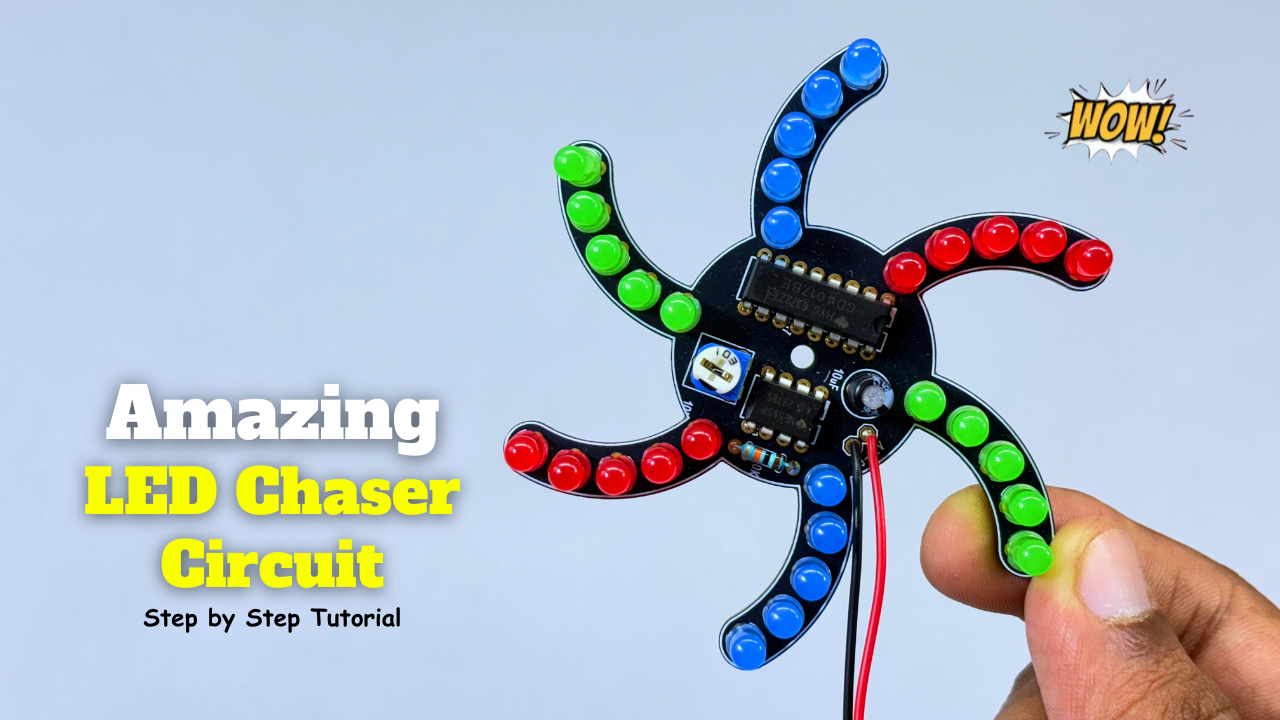A gas sensor is a device that detects the presence and concentration of gases in the air. It operates by converting a physical or chemical change caused by a specific gas into an electrical signal, which can be measured and analyzed. Gas sensors are critical for monitoring and ensuring safety, health, and environmental conditions in various applications.
Gas sensors provide early warning for harmful gas exposure, enhance safety, and contribute to environmental protection. Their integration into systems allows for real-time monitoring and automated response to dangerous conditions.
In summary, gas sensors are essential tools in diverse fields, offering precise and reliable detection of various gases to safeguard human health and the environment.
Components Used:
- MQ-6 Gas Sensor.
- Relay module 5v.
- Siren
- Switch
- 3.7v battery
- 9v battery
- Jumper Wires


Circuit Diagram:

MQ-6 sensor
The MQ-6 sensor is a semiconductor gas sensor primarily used for detecting the presence of liquefied petroleum gas (LPG), isobutane, propane, and other combustible gases in the air. It operates by using a tin dioxide (SnO2) sensitive layer whose conductivity increases in the presence of the target gases. This change in conductivity is then converted into an output signal, which can be read by a microcontroller or an analog-to-digital converter (ADC) for further processing.
The MQ-6 sensor is favored for its high sensitivity, quick response time, and low cost. It typically features two output modes: analog output, which provides a continuous voltage signal corresponding to the gas concentration, and digital output, which triggers when the gas concentration exceeds a preset threshold.
Common applications of the MQ-6 sensor include gas leak detection systems in homes and industrial settings, safety monitoring in vehicles and storage facilities, and various DIY electronics projects involving gas detection. The sensor is usually integrated into a module with other electronic components to facilitate easy connection to microcontroller boards like Arduino and Raspberry Pi. Proper calibration is essential for accurate gas detection and to ensure reliable performance in diverse environments.
Working
The MQ-6 gas sensor operates based on the principle of changes in conductivity of the sensor material in response to the presence of target gases. Here’s a detailed explanation of its working mechanism:
- Sensor Composition: The MQ-6 sensor is built around a tin dioxide (SnO2) sensitive layer. This semiconductor material’s electrical resistance varies significantly when exposed to different gas concentrations.
- Heating Element: An internal heating element heats the sensor to a specific temperature, enhancing its sensitivity to gases like LPG, isobutane, and propane. The heating element ensures the sensor operates within its optimal temperature range, typically around 300-500°C.
- Gas Interaction: When the target gases come into contact with the heated tin dioxide surface, a redox (reduction-oxidation) reaction occurs. The gases donate or accept electrons, altering the resistance of the tin dioxide layer.
- Resistance Change: In the presence of reducing gases (like LPG, propane, and isobutane), the resistance of the SnO2 layer decreases. This is because the gases interact with oxygen ions on the sensor’s surface, freeing up electrons and thus increasing the material’s conductivity.
- Signal Output: The sensor’s resistance change is translated into an electrical signal. The MQ-6 typically provides an analog voltage output that varies with the concentration of the detected gas. This output can be read by a microcontroller or an analog-to-digital converter (ADC) to determine the gas concentration.
- Calibration: The sensor requires calibration to establish a baseline resistance in clean air and to set threshold values for detecting specific gas concentrations. Proper calibration ensures accurate detection and reliable performance in different environments.
Applications:
The MQ-6 gas sensor is commonly used in gas leak detection systems, safety alarms, and various industrial applications to monitor air quality and ensure safety by detecting hazardous gas levels. Its high sensitivity and relatively low cost make it a popular choice for both commercial and DIY projects.
In summary, the MQ-6 gas sensor works by utilizing the change in conductivity of tin dioxide in response to combustible gases, converting these changes into readable electrical signals to detect and measure gas concentrations.


Relay Module:
A single channel relay module is an electronic device used to control high voltage devices through low voltage signals. It acts as an interface between microcontrollers (like Arduino, Raspberry Pi) and high-power devices, allowing the low-power control signal to switch on or off a higher power circuit. The relay itself is an electrically operated switch that can handle high voltage loads safely.

Key components of a single channel relay module include:
- Relay: The core component, which operates the switch.
- Optocoupler: Provides electrical isolation between the control signal and the relay, protecting the low voltage control side from high voltage spikes.
- Transistor/Driver Circuit: Amplifies the low current control signal from the microcontroller to a level sufficient to operate the relay.
- Diode: Protects the circuit from voltage spikes caused by the inductive load of the relay coil.
- Indicator LED: Shows the status of the relay (on or off).
Typical applications of single channel relay modules include home automation (e.g., turning lights and appliances on/off), industrial control systems, and robotics. They are easy to use, with input pins for connecting to the microcontroller, and output terminals for the high voltage load. The module’s design ensures safe and efficient switching of high power loads without direct exposure to the user, making it an essential component in many electronics projects.


18650 Battery
The 18650 battery is a cylindrical lithium-ion rechargeable battery commonly used in various electronic devices and applications due to its high energy density, long cycle life, and reliable performance. The name “18650” refers to its dimensions: 18 mm in diameter and 65 mm in length.
Key features of the 18650 battery include:
- High Energy Density: These batteries typically offer a capacity ranging from 1800mAh to 3500mAh or more, providing significant power storage in a compact size.
- Long Cycle Life: An 18650 battery can undergo hundreds to thousands of charge-discharge cycles while maintaining a large percentage of its original capacity, making it suitable for long-term use.
- Stable Voltage: The nominal voltage of an 18650 cell is usually around 3.7V, with a typical charging cut-off voltage of 4.2V and a discharge cut-off around 2.5V to 3.0V.
- Safety Features: Many 18650 batteries come with built-in protection circuits to prevent overcharging, over-discharging, and short-circuiting, enhancing user safety.
Common applications of 18650 batteries include:
- Consumer Electronics: Laptops, flashlights, and portable power banks.
- Electric Vehicles: Used in battery packs for electric cars and bikes.
- Power Tools: Providing reliable power for cordless tools.
- Renewable Energy Storage: Integrated into solar and wind energy storage systems.
The versatility and efficiency of 18650 batteries have made them a cornerstone in both consumer electronics and larger-scale energy applications. However, proper handling and charging practices are essential to ensure safety and longevity.


More Projects
-
Meet the Cutebot Pro – The smartest Micro:bit Robot Car!
The CuteBot Pro is a programmable robot-car kit designed for STEAM/robotics education.Key features include: Obstacle Avoiding Car Line Following Car More Projects
-
Create a Stunning Heart LED chaser Circuit with Simple Electronics
An LED chaser is an electronic circuit that lights LEDs one after another in a sequence. It creates a running or chasing light effect commonly seen in decorations and indicators. …
-
Amazing LED Chaser Circuit – Beautiful Decoration Idea
An LED chaser is an electronic circuit that lights LEDs one after another in a sequence. It creates a running or chasing light effect commonly seen in decorations and indicators. …



